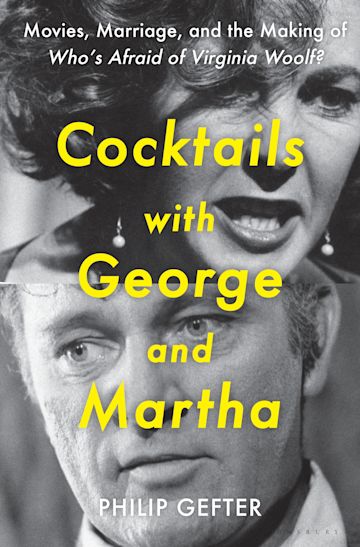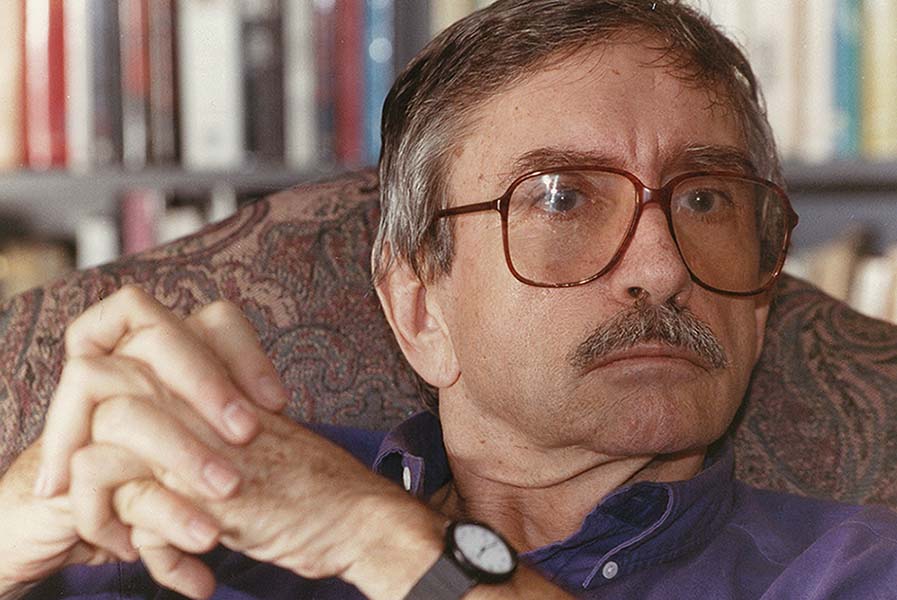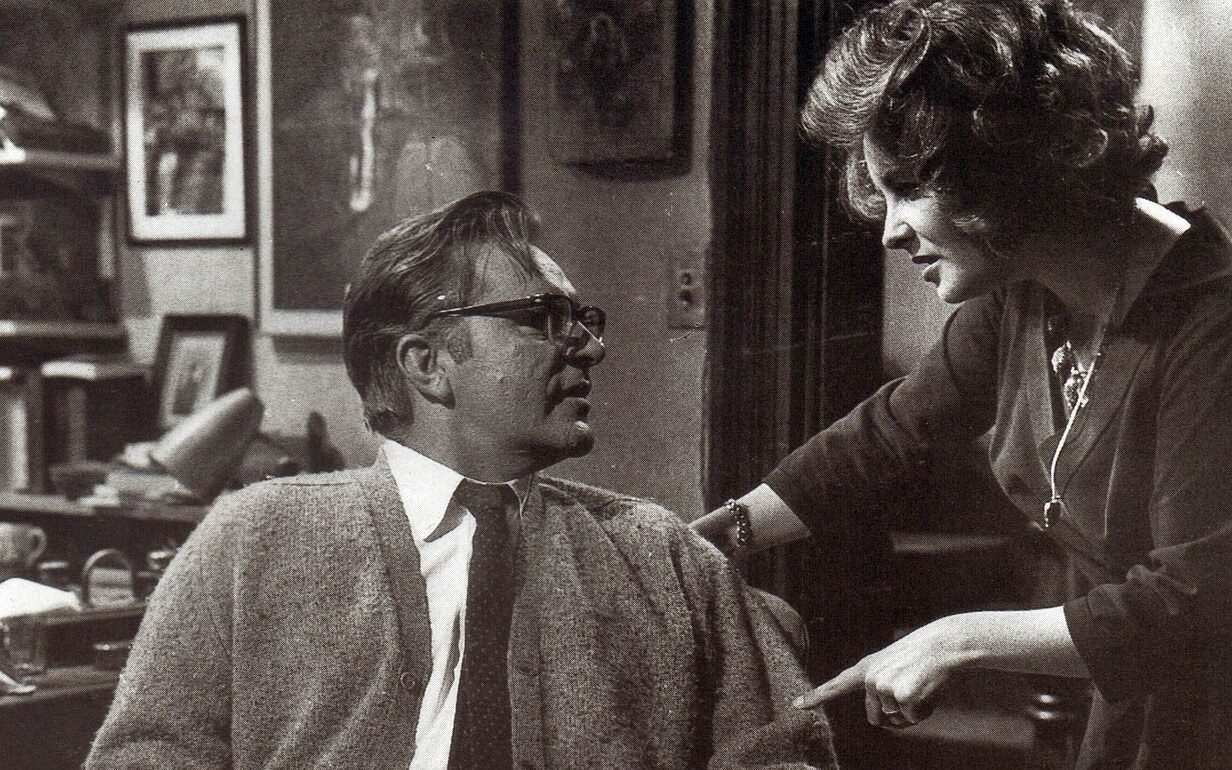In the cringetastic first-season finale of Succession, newly married Siobhan “Shiv” Roy and Tom Wambsgans enter into a brutal negotiation on their wedding night. She admits to an undefined number of past infidelities, determined to maintain an open marriage. Tom, aghast but expedient, acquiesces. Their alliance is strangled at birth, as it were, and by the series’ end, the pair remain shackled, even if the power position has flipped.
Author Philip Gefter might argue that Tom and Shiv’s practical yet poisoned arrangement owes a profound debt to Edward Albee’s Who’s Afraid of Virginia Woolf? In his highly entertaining Cocktails with George and Martha, published earlier this year, Gefter blends a juicy account of the filming of the breakthrough drama starring Elizabeth Taylor and Richard Burton with a 20th-century cultural history of marriage in popular culture—in which Woolf was pivotal.

A lively and engaging writer equally fascinated by Albee’s masterpiece and the intricate dynamics of couples, Gefter acknowledges early on the deeply meta casting of the 1996 film. “Watching any couple fight is awkward at best, a too-intimate window onto a marriage,” he observes. “It leaves the witness feeling like a voyeur sneaking a peek at something private, illicit. Watching George and Martha go at each other summons our embarrassment as much as our curiosity. It only adds to the mystique that Taylor and Burton brought their own mercurial real-life marriage to their on-screen roles.”
Of course, Taylor and Burton (Lizadick?) isn’t the only fractious twosome at this Hollywood bash: When studio head Jack Warner greenlit Woolf, it meant that screenwriter and producer Ernest Lehmann would find himself hitched to director Mike Nichols, a diva who could have schooled Martha herself in emotional blackmail.
Several intimate unions slide under Gefter’s microscope for inspection. First and most crucial is the formative romance between Edward Albee and William Flanagan, the much older composer and bon vivant who squired the 20-ish Albee—his lover and protégé—around Greenwich Village bars and parties. Gefter begins at the beginning: Albee and Flanagan were sharing an apartment on West Fourth Street when, in 1954, the budding playwright spotted a graffito scrawled on a barroom mirror in dry soap: “Who’s afraid of Virginia Woolf?” About six years later, as Albee began to work on a new piece about bickering couples on a college campus amid copious booze and an imaginary baby, he plucked the campy pun from memory and had his title. By then, Albee was a cultural sensation in the wake of The Zoo Story and had traded Flanagan for the much-younger Terrence McNally.
Gefter’s lucid history of the creation, production, and reception of Virginia Woolf on Broadway, besides being a yummy read, includes thoughtful analysis about the likely inspiration for George and Martha: poet Willard Maas and painter Marie Menken. This hard-drinking bohemian couple were faculty liaisons to the New York City Writers Conference, where Albee ran the playwriting program. Maas and Menken’s marathon drinking parties were the stuff of legend, no less than their tendency to performatively lash into each other in front of guests. Without needing to do it explicitly, Gefter’s book draws a straight-ish line from this obscure academic dyad to Taylor and Burton, the world’s most famous lovers in 1963, similarly marinated in booze and bile.

Although a good deal of Cocktails’ quotes and anecdotes are sourced from biographies of Albee and Nichols by Mel Gussow and Mark Harris, respectively, as well as books on Burton and Taylor and a dozen contemporaneous press articles, Gefter has a secret weapon in his reporting arsenal. Screenwriter-turned-producer Lehman (The Sweet Smell of Success) kept a minutely observed diary from pre-production to editing and screening. “At the end of every day,” Gefter writes, “Lehman strode to his Cadillac sedan in his designated parking space on the Warner Brothers lot, and on the drive home to Brentwood he spoke into a Dictaphone, recounting the events of the day…monitoring his role as producer-screenwriter, and expressing his feelings.” Drawing freely on this journal (housed in the Harry Ransom Center at UT-Austin), Gefter adds a bonanza of insight, gossip, and fly-on-the-wall detail. We know that liver-destroying amounts of alcohol are consumed by the characters of Virginia Woolf, but here are some of the liquid gifts the stars received upon arrival in Hollywood:
[Lehman] could not send the same gift to everyone, nor repeat a gift anyone else had sent. He learned that Jack Warner, for example, had sent the Burtons a huge floral arrangement, six bottles of champagne, a case of Scotch, and a case of gin. Lehman flinched when he heard that Nichols was sending a pound of caviar to their home.
In the same spirit, Gefter gets one of his best lines from Lehman’s journal. The night before rehearsals begin, Nichols confides his doubts to the producer. He fretfully wishes Lehman had cast Bette Davis; Taylor is too pretty, too young, not flinty or salty enough to play Martha. “Asking Taylor to play Martha, Mike fretted to Lehman, was ‘like asking a chocolate milkshake to do the work of a double martini.’”
Clearly, while Gefter’s admiration goes to the wildly talented and audacious Nichols, his sympathies lie with the screenwriter-producer, who saw his script innovations rolled back and his authority tested at every step by the precocious first-time director. Burton and Taylor, second only to Warner in terms of veto power, pitched their own battles over the length of shooting days. In a chapter titled “The Producer’s Other Cheek,” Gefter tracks the petty temper tantrums and celebrity misbehavior Lehman had to manage day after day: lavish jewelry for Liz, who expected pricey gifts; Nichols’s barely veiled contempt one day and neurotic supplication the next; Burton’s legendary drunken abusiveness.
Recapping whole scenes with ekphrastic elan when not detailing numerous dustups between Nichols and Lehman, stuffy directors of photography, and of course, Warner—relentless in urging Nichols to shoot in color—the book is a loving homage to a great film which came at exactly the right time. Released at a threshold cultural moment, midway through the 1960s and before a flood of permissiveness and taboo-breaking, Gefter sees it as “a clear dividing line” in films’ depiction of marriage. “Those that preceded Woolf addressed the central relationship at varying distances, with other themes often predominating; in those films that followed, marriage could be approached more directly as the driving narrative force.” No matter how long you’ve adored Woolf (in either medium), this insightful, stylish chronicle may have you gazing at a longtime companion with fresh—even passionate—eyes. Don’t forget: George and Martha love to fight another day.
David Cote is a journalist, playwright, and opera librettist based in New York City. His reviews and reporting also appear in The A.V. Club, Observer, and 4 Columns.


